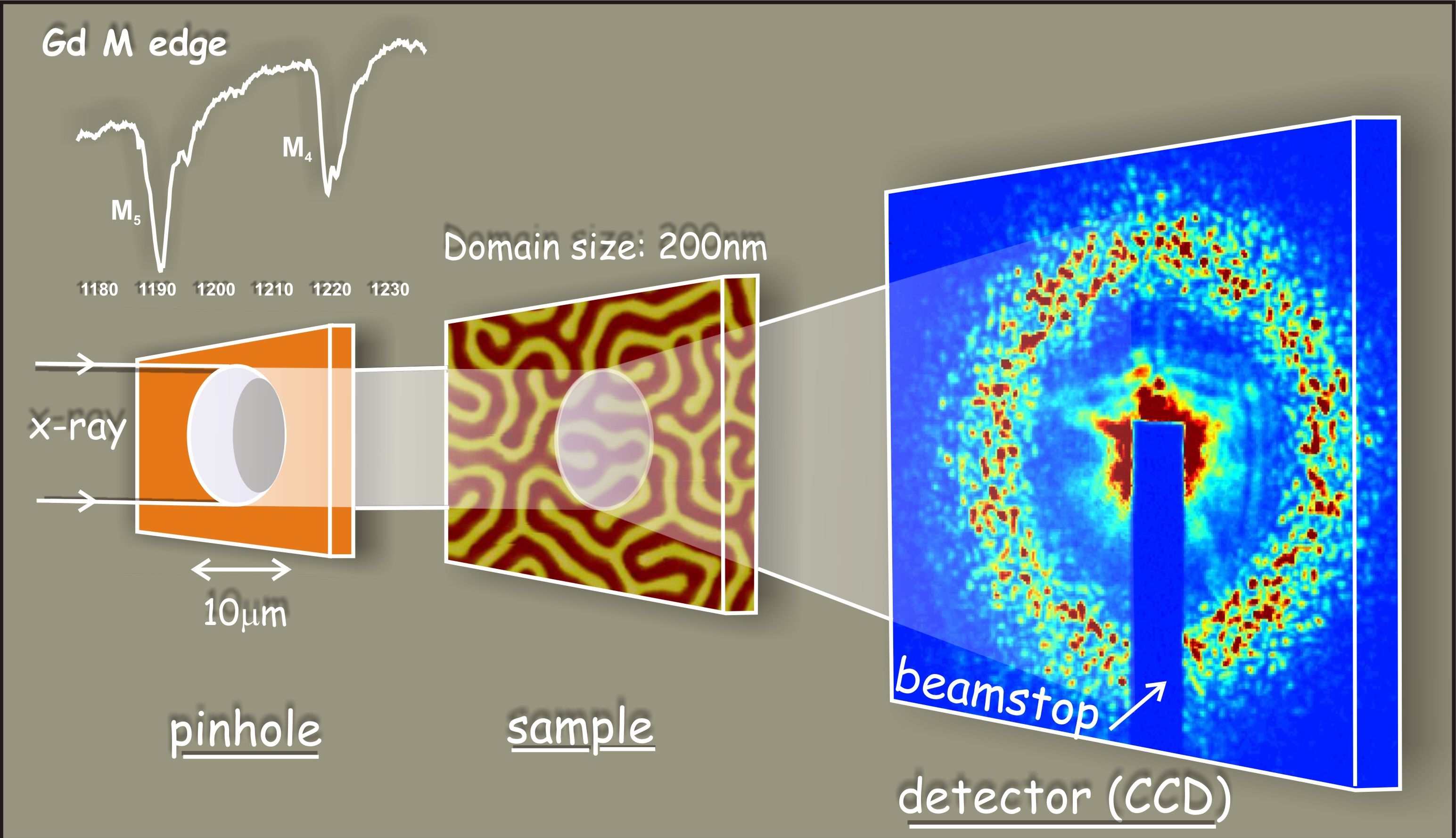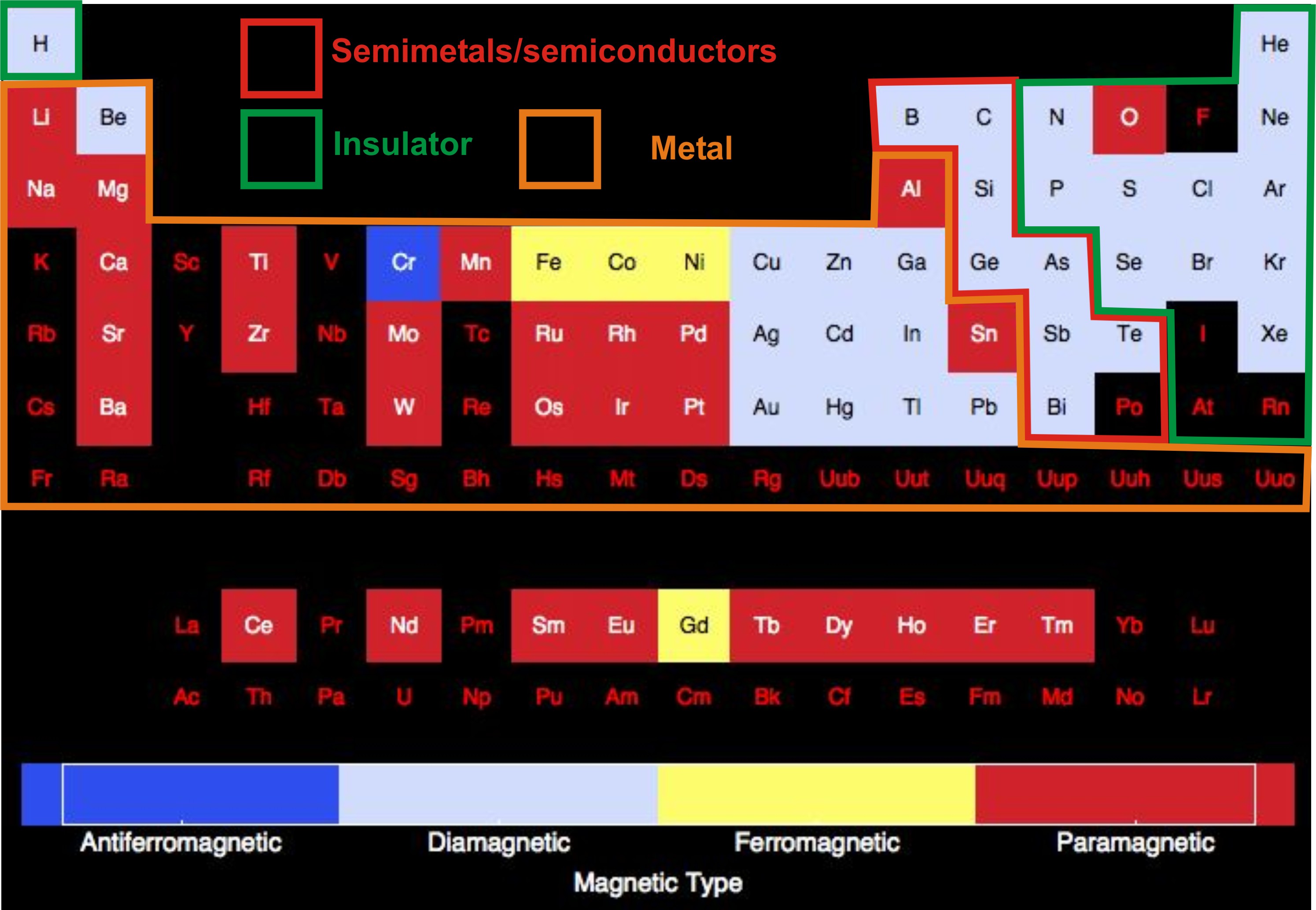
PMA in magnetic thin film and Multilayers
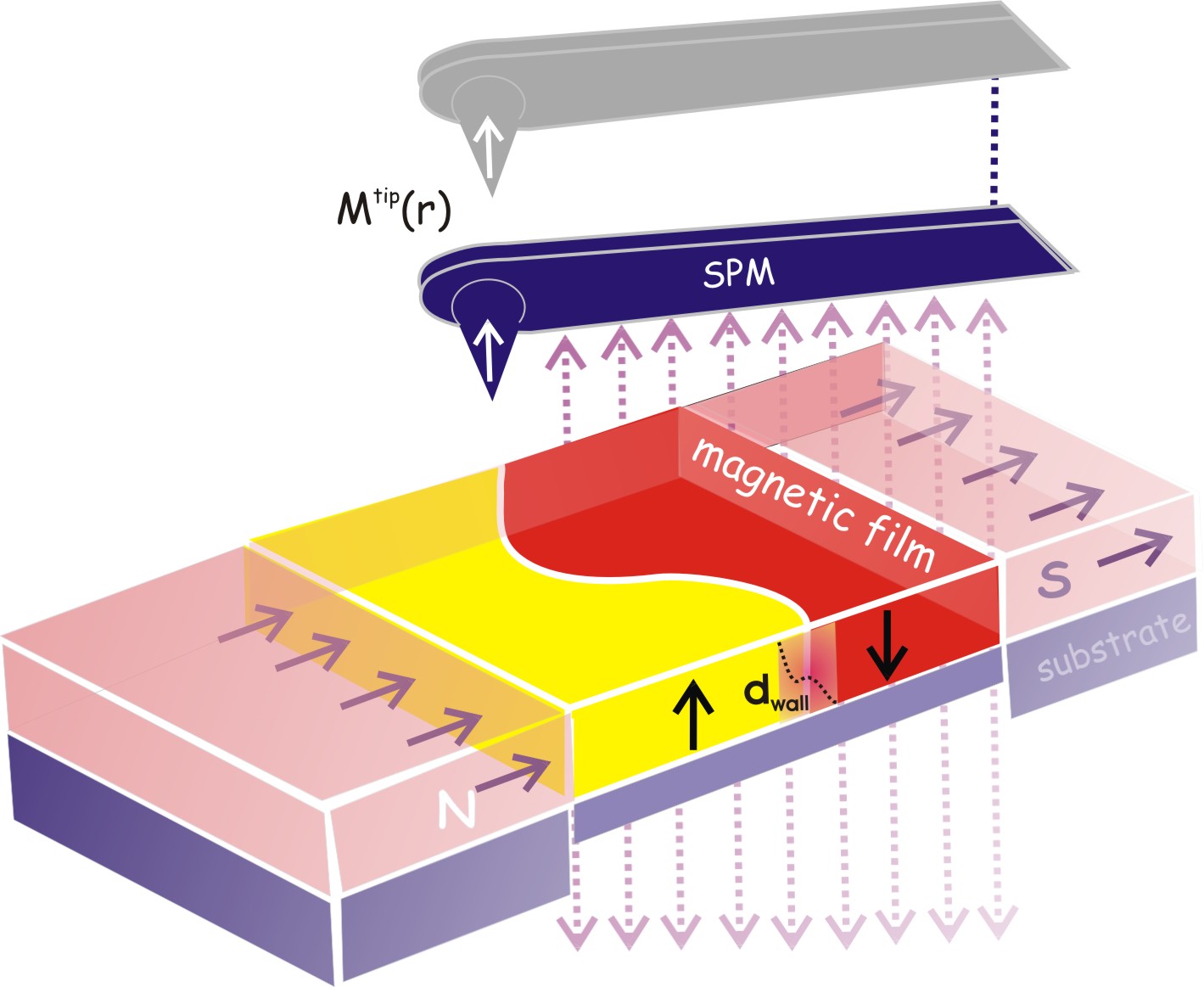 Magnetic thin films and
multilayer have ushered in a new era in magnetic and magneto-optical
recording technology. With the advent of materials having strong
perpendicular magnetic anisotropy (PMA), high density (1 Tb/inch2) data
storage is being attempted. Higher PMA makes the system magnetically
stable
by getting rid of thermal fluctuation of spins, which is technically
known as super-paramagnetism. The problem associated with higher PMA
sample is higher coercivity. This offers a new challenge for writing
the media within the limited field of the existing write heads. To
circumvent this problem, heat assisted magnetic recording (HAMR) has
been investigated, where the intention is to make the magnetic
anisotropy locally weaker and switch it with a comparatively lower
magnetic field. However, the implementation of this method in a
portable device is not straight forward. So, the search for different
methods of anisotropy tuning by external perturbations or by growth
mediated intrinsic ways gain active interest of contemporary research. Our work deals with
different methods of anisotropy tuning (both
intrinsic and extrinsic) in materials with higher PMA for possible
applications. For this purpose, we propose the material system,
consisting of rare-earth and transition metal (RE-TM) alloy thin films
(single layer) as well as multilayer of the constituent metals. The
presence of transition metal contributes to the higher Curie
temperature and the rare-earth elements are responsible for higher
magnetostriction. The other important property includes the tuneable
PMA for the case of ferrimagnetic RE-TM systems. We will be
investigating the alloys and multilayer of TM and RE, where both the
sub-lattices couple antiferromagnetically and hence the material shows
a ferrimagnetic behaviour. This material is extremely interesting
because it is a soft magnetic material along with a controllable PMA
with film thickness, composition, deposition methods and associated
stress as well as external perturbations. GdFe systems with PMA has
been investigated for magneto-optical recording, it is proved to be
very applicable for bubble memories, whereas it shows magnetostriction
with tuned in-plane magnetic anisotropy.
Magnetic thin films and
multilayer have ushered in a new era in magnetic and magneto-optical
recording technology. With the advent of materials having strong
perpendicular magnetic anisotropy (PMA), high density (1 Tb/inch2) data
storage is being attempted. Higher PMA makes the system magnetically
stable
by getting rid of thermal fluctuation of spins, which is technically
known as super-paramagnetism. The problem associated with higher PMA
sample is higher coercivity. This offers a new challenge for writing
the media within the limited field of the existing write heads. To
circumvent this problem, heat assisted magnetic recording (HAMR) has
been investigated, where the intention is to make the magnetic
anisotropy locally weaker and switch it with a comparatively lower
magnetic field. However, the implementation of this method in a
portable device is not straight forward. So, the search for different
methods of anisotropy tuning by external perturbations or by growth
mediated intrinsic ways gain active interest of contemporary research. Our work deals with
different methods of anisotropy tuning (both
intrinsic and extrinsic) in materials with higher PMA for possible
applications. For this purpose, we propose the material system,
consisting of rare-earth and transition metal (RE-TM) alloy thin films
(single layer) as well as multilayer of the constituent metals. The
presence of transition metal contributes to the higher Curie
temperature and the rare-earth elements are responsible for higher
magnetostriction. The other important property includes the tuneable
PMA for the case of ferrimagnetic RE-TM systems. We will be
investigating the alloys and multilayer of TM and RE, where both the
sub-lattices couple antiferromagnetically and hence the material shows
a ferrimagnetic behaviour. This material is extremely interesting
because it is a soft magnetic material along with a controllable PMA
with film thickness, composition, deposition methods and associated
stress as well as external perturbations. GdFe systems with PMA has
been investigated for magneto-optical recording, it is proved to be
very applicable for bubble memories, whereas it shows magnetostriction
with tuned in-plane magnetic anisotropy.
Magnetic Nanostructure by tunable Electrodeposition
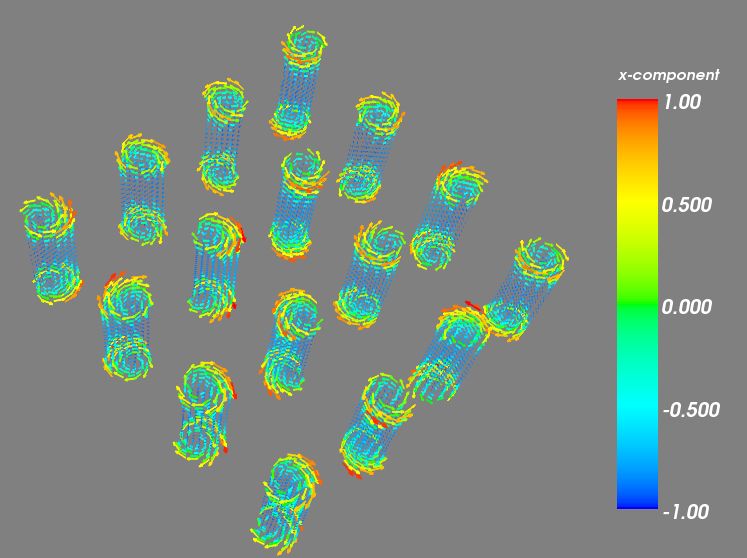
Magnetic thin film and nanowires are promising candidates for future spintronics and data storaga applications. Fabrication of such materials with a larger area and low-cost can be acheived by tunable electrodepostion. Correlation of different growth mechanism with structural, magnetic and morphological proerties of the materials are important for potential applications. In recent years, ferromagnetic nanowires got considerable attention due to its large aspect ratio and uniaxial anisotropy. Magnetic nanowires have potential applications in ultra-high density data storag. Template assisted electrodeposition is widely used to fabricate such nanowires due to its raliability, reproducibility and low cost.
Multiferroic
and Magneto-electric Materials
 Exploring
complex
phenomena and many-body effects in multiferroics and magnetoelectric
heterostructure has lot of possible applications in memeory devices,
sensors and photovoltaics.The
key to their advanced functionality is the ability to manipulate
magnetization
with the electric field, and polarization via the magnetic field.
Investigation
for high magnetoelectric in a single-phase multiferroic system is one
of the
key challenges in this research field. The combination of piezoelectric
and
magnetostriction phenomena is allowing researchers to understand the
effects of
real multiferroic system at room temperature, with high coupling
parameters. Our
understanding not only limits to fundamental properties such as
magnetic,
electric, dielectric etc. of these multifunctional materials but also
extends
to implementation into the practical application such as non-volatile
resistive
random access memory (RRAM), solar-cell, sensor etc.
Exploring
complex
phenomena and many-body effects in multiferroics and magnetoelectric
heterostructure has lot of possible applications in memeory devices,
sensors and photovoltaics.The
key to their advanced functionality is the ability to manipulate
magnetization
with the electric field, and polarization via the magnetic field.
Investigation
for high magnetoelectric in a single-phase multiferroic system is one
of the
key challenges in this research field. The combination of piezoelectric
and
magnetostriction phenomena is allowing researchers to understand the
effects of
real multiferroic system at room temperature, with high coupling
parameters. Our
understanding not only limits to fundamental properties such as
magnetic,
electric, dielectric etc. of these multifunctional materials but also
extends
to implementation into the practical application such as non-volatile
resistive
random access memory (RRAM), solar-cell, sensor etc.
Carbon Based Nanosystem:
 The
uniqueness of
structure and properties of carbon nanotubes (CNTs) endorse them as
potential material
for research and device applications in almost all the areas. Growth
of CNTs on conducting substrate is of high importance because outstanding
electronic properties of CNTs can be fully exploited for potential
applications
in electronic devices. However, the growth of MWCNT on conducting
substrates
has been proven to be a challenging task because of the non-feasibility
of
catalyst diffusion and nucleation. Growth on conducting substrates such
as
copper (Cu) and stainless steel (SS) as well and on non-conducting
substrates has
been achieved using thermal CVD without any pre-deposition or
pre-pattering. The
performance of such CNTs in applications depend on the crystallinity,
orientation,
defects concentrations, work function and electrical resistance. The
properties
like work function and electrical resistance involves great influence
of
substrate-catalyst-CNT interaction. Filling
of hollow core of CNTs with various
materials such as metals,
semiconductors, salts, organic materials, has
advanced the application of CNTs in various areas. This is because in
filled-CNTs, tube-walls protect the filled
materials against
oxidation
and harsh environment and thus exhibit
superior physical, chemical or electronic properties. Among all the possible fillers, ferromagnetic
materials are of great importance because they act as
catalyst for growth and as grown CNTs encapsulated with such tiny
nanomagnet
has astonishing magnetic properties. These tiny magnets are confined
inside CNT
core and make whole CNTs permanently magnetized. Because of minimum magnetic coupling, magnetic
properties of such confined
well separated (by CNT-walls) tiny ferromagnetic nanorods such
nanostructures
enhance in terms of higher coercivity or saturation magnetization and
thus highly desirable in
magnetic devices. The
direction of magnetization in these encapsulated nanorod is a crucial
factor as
it influences the overall magnetization of the CNTs and usually depend on the anisotropies.
If direction of magnetization can be
controlled,
filled-CNT could be novel material for many devices.
The
uniqueness of
structure and properties of carbon nanotubes (CNTs) endorse them as
potential material
for research and device applications in almost all the areas. Growth
of CNTs on conducting substrate is of high importance because outstanding
electronic properties of CNTs can be fully exploited for potential
applications
in electronic devices. However, the growth of MWCNT on conducting
substrates
has been proven to be a challenging task because of the non-feasibility
of
catalyst diffusion and nucleation. Growth on conducting substrates such
as
copper (Cu) and stainless steel (SS) as well and on non-conducting
substrates has
been achieved using thermal CVD without any pre-deposition or
pre-pattering. The
performance of such CNTs in applications depend on the crystallinity,
orientation,
defects concentrations, work function and electrical resistance. The
properties
like work function and electrical resistance involves great influence
of
substrate-catalyst-CNT interaction. Filling
of hollow core of CNTs with various
materials such as metals,
semiconductors, salts, organic materials, has
advanced the application of CNTs in various areas. This is because in
filled-CNTs, tube-walls protect the filled
materials against
oxidation
and harsh environment and thus exhibit
superior physical, chemical or electronic properties. Among all the possible fillers, ferromagnetic
materials are of great importance because they act as
catalyst for growth and as grown CNTs encapsulated with such tiny
nanomagnet
has astonishing magnetic properties. These tiny magnets are confined
inside CNT
core and make whole CNTs permanently magnetized. Because of minimum magnetic coupling, magnetic
properties of such confined
well separated (by CNT-walls) tiny ferromagnetic nanorods such
nanostructures
enhance in terms of higher coercivity or saturation magnetization and
thus highly desirable in
magnetic devices. The
direction of magnetization in these encapsulated nanorod is a crucial
factor as
it influences the overall magnetization of the CNTs and usually depend on the anisotropies.
If direction of magnetization can be
controlled,
filled-CNT could be novel material for many devices.
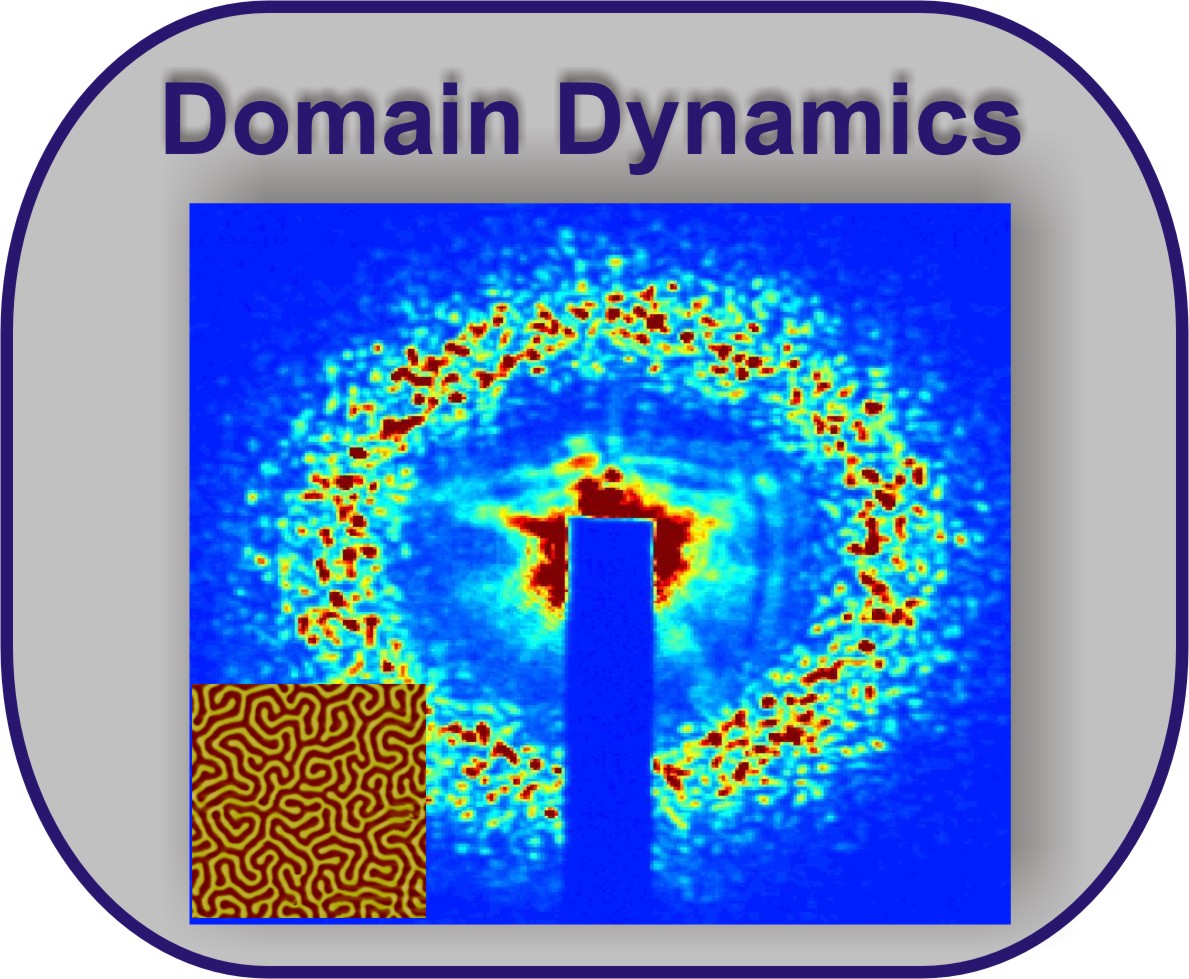 Modern
magnetic devices
(GMR
read heads,
magnetic sensors, hard disks and spintronics devices) relies on storing
or manipulating magnetic information in smaller length scales (nms) at
faster time scales (nanoseconds to femto seconds). It is very
important to know the magnetic structure in order to understand the
magnetic device. For example, we want to know how a magnetic device
behaves in presence of magnetic field or what if we put two magnetic
elements in close proximity, how does the magneto-resistance (GMR
effect) behavior changes in different nano-element. All these questions
are related to the magnetic structure of the sample or
device.
There are different energies acting in a magnetic system these are due
to exchange anisotropy, shape anisotropy, magneto-crystalline
anisotropy, magneto-striction, self-energy of the system. As a result
of the competition between the different energies magnetic system
breaks into regions of constant magnetization called magnetic domains
separated by domain walls where magnetization change from one direction
to the other. Magnetic domains are important part of the magnetic
system and one need to understand how these domain forms and how can we
see them with better spatial and temporal resolution. Advancement of
nano-science allows us to prepare structure in nanometer scale both by
self-assembly and electron beam lithography. When physical dimension of
the system becomes comparable to length scale of the system then one
starts to see new phenomena. For an example, magnetic particles or
lithographically patterned thin film elements that are smaller than a
domain wall width might be expected to be in a single domain state.
There are many different imaging techniques one can use to see these
domains and study their dynamics.
Modern
magnetic devices
(GMR
read heads,
magnetic sensors, hard disks and spintronics devices) relies on storing
or manipulating magnetic information in smaller length scales (nms) at
faster time scales (nanoseconds to femto seconds). It is very
important to know the magnetic structure in order to understand the
magnetic device. For example, we want to know how a magnetic device
behaves in presence of magnetic field or what if we put two magnetic
elements in close proximity, how does the magneto-resistance (GMR
effect) behavior changes in different nano-element. All these questions
are related to the magnetic structure of the sample or
device.
There are different energies acting in a magnetic system these are due
to exchange anisotropy, shape anisotropy, magneto-crystalline
anisotropy, magneto-striction, self-energy of the system. As a result
of the competition between the different energies magnetic system
breaks into regions of constant magnetization called magnetic domains
separated by domain walls where magnetization change from one direction
to the other. Magnetic domains are important part of the magnetic
system and one need to understand how these domain forms and how can we
see them with better spatial and temporal resolution. Advancement of
nano-science allows us to prepare structure in nanometer scale both by
self-assembly and electron beam lithography. When physical dimension of
the system becomes comparable to length scale of the system then one
starts to see new phenomena. For an example, magnetic particles or
lithographically patterned thin film elements that are smaller than a
domain wall width might be expected to be in a single domain state.
There are many different imaging techniques one can use to see these
domains and study their dynamics.
- Resolution: Nearly atomic resolution both laterally and as a function of depth.
- Dynamics: Fast enough to follow the magnetization dynamics on a timescale comparable to that of the spin precession.
- Environment: Image the magnetization in the magnetic field, at different temperature.
- Visibility: Image the magnetization in devices that may be buried under non-magnetic layers or deposited on top of complex structures. Should be able to see the interface between layers.
- Non-invasive:Imaging must be done without disturbing the magnetic structure of the device.
- Quantitative Information: Should provide orbital and spin component of the magnetization and also the magnetization distribution.
- Element Specific:Should provide information on each element in the system.
No single, current imaging technique can satisfy all of these demands. In order to get a more complete picture of the magnetic structure, therefore, multiple complementary imaging methods should be used.
Coherent Scattering:
We are interested in studying the evolution of magnetic domains and effect of pinning centers in thin film magnetic systems as a function of magnetic field, temperature, and doping to identify the role the disorder in formation and stability of the magnetic domainsusing resonant magnetic x-ray coherent scattering. This technique allows us to use element specificity as well as depth resolution to understand the magnetic domains and their dynamics. In particular, we are interested in Fe/Gd and FeGdTb multilayer exhibiting ordered stripes due to perpendicular magnetic anisotropy (PMA).This system was chosen in order to have maximum magnetic contrast, negligible charge scattering and minor multiple scattering. We propose to study the effects of field pinning of the local magnetic structure of these systems through their magnetization hysteresis loops and their temperature driven dynamics.Comparison of the magnetic speckles (in momentum space) provides information on correlation between the magnetic structures (in real space). This metrology approach has been recently applied to study Return and Complimentary Point Memory in other magnetic system. If the speckles are dynamic, which indicates that domains are fluctuating rather than frozen, we can use speckle intensity fluctuations in X-ray Photon Correlation Spectroscopy mode to investigate the effects of temperature and magnetic field on these domain wall fluctuation. We then plan to study the Barkhausen noise spectrum following the applied field, and to extend this study to Tb doping in these systems, which would induce strong PMA. Tuning the x-ray energy to the sharp magnetic resonances can provide information about the magnetic contributions to the domains.
Fe/Gd multilayers and higher periodicity of Fe/Gd layer] were grown at room temperature by sputtering Fe and Gd onto a 100nm thick Si3N4 membrane. Standard magnetic hysteresis measurements [magneto-optic Kerr effect (MOKE) and vibrating sample magnetometer (VSM)] show perpendicular anisotropy. From these measurements the anti-ferromagnetic coupling between Fe and Gd is evident.
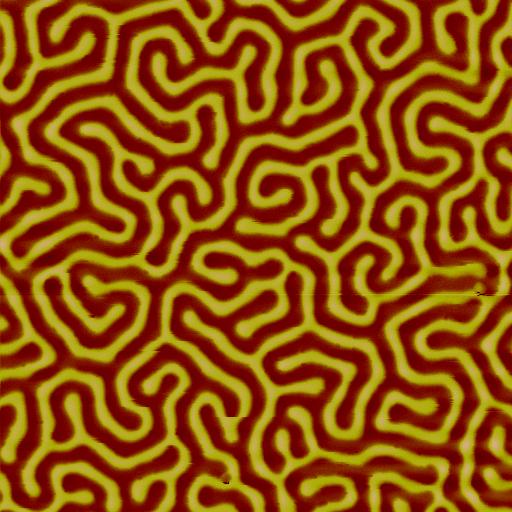 The magnetization in these
systems breaks up
in domains (width of about 250nm) of different directions in order to
reduce the stray field energy. The formation of these domains coincides
with the creation of domain walls where the magnetization rotates from
one direction to the other at the expense of the exchange and
anisotropy energies. Magnetic force
microscopy (MFM)
images show clear maze-like domain structure as a result of strong
perpendicular anisotropy. MFM is sensitive to out-of-plane
magnetization as the magnetic tip used for measuring the magnetic stray
field of the sample is always magnetized along the tip axis and hence
sensitive to the out-of-plane component of the magnetization. The dark
and bright contrasts in the MFM images are due to magnetization of the
sample pointing out-of-plane and into-the-plane, respectively. At each
ramification of a domain the three branches are oriented at angles of
about 120o relative
to each other. This behavior can be traced back to repulsive dipolar
force among the equally magnetized domains.
The magnetization in these
systems breaks up
in domains (width of about 250nm) of different directions in order to
reduce the stray field energy. The formation of these domains coincides
with the creation of domain walls where the magnetization rotates from
one direction to the other at the expense of the exchange and
anisotropy energies. Magnetic force
microscopy (MFM)
images show clear maze-like domain structure as a result of strong
perpendicular anisotropy. MFM is sensitive to out-of-plane
magnetization as the magnetic tip used for measuring the magnetic stray
field of the sample is always magnetized along the tip axis and hence
sensitive to the out-of-plane component of the magnetization. The dark
and bright contrasts in the MFM images are due to magnetization of the
sample pointing out-of-plane and into-the-plane, respectively. At each
ramification of a domain the three branches are oriented at angles of
about 120o relative
to each other. This behavior can be traced back to repulsive dipolar
force among the equally magnetized domains.
Resonant Magnetic Speckle:
X-ray scattering is non-invasive as far as domain mapping is concerned. Element sensitivity and depth resolution are the key advantages of x-rays to study magnetic materials.To study the dynamics two most tuning parameter, temperature and magnetic field can easily be added to existing set-up with nominal modification. By contrast, MFM is an invasive technique in which one may influence the magnetic domains of the sample by the stray field of the tip or vice versa.Imaging in the presence of moderate magnetic field (above 200 Gauss) is difficult as it changes the magnetization of the tip. Moreover, one observes an after-effect in response to the tip magnetization or the external field.Using resonant magnetic x-ray scattering we can probe fluctuations in the domains and their dynamics. Spin-orbit splitting at the L and M absorption edges affords direct access to the domain magnetization vector.
Different type of domains may result depending on the magnetic history of the sample. Application of magnetic field in the perpendicular direction results in randomly oriented "maze" domains, whereas in-plane field creates stripes preferentially oriented along the field direction. Increasing magnetic field results in change of the stripe structure to bubbles and then saturated at higher field value. At saturation, film transfer to single domain state. MFM shows only bright or dark contrast depending on whether one measure at the positive or negative saturation field following the hysteresis loop.Formation, shape and stability of perpendicularly magnetized domains can be explained by the competition of the short range exchange interaction and the long range magnetostatic interaction. At higher magnetic fields a lattice of bubble domains has lower energy than stripe domains. Thus, a critical external field exists, where stripe domains become instable and collapse into bubble domains. It will be interesting to see the evolution of the domain pattern as a function of temperature. As the saturation magnetization goes down one can predict that at higher temperature the magnetization goes in-plane which would result in weak magnetic contrast.
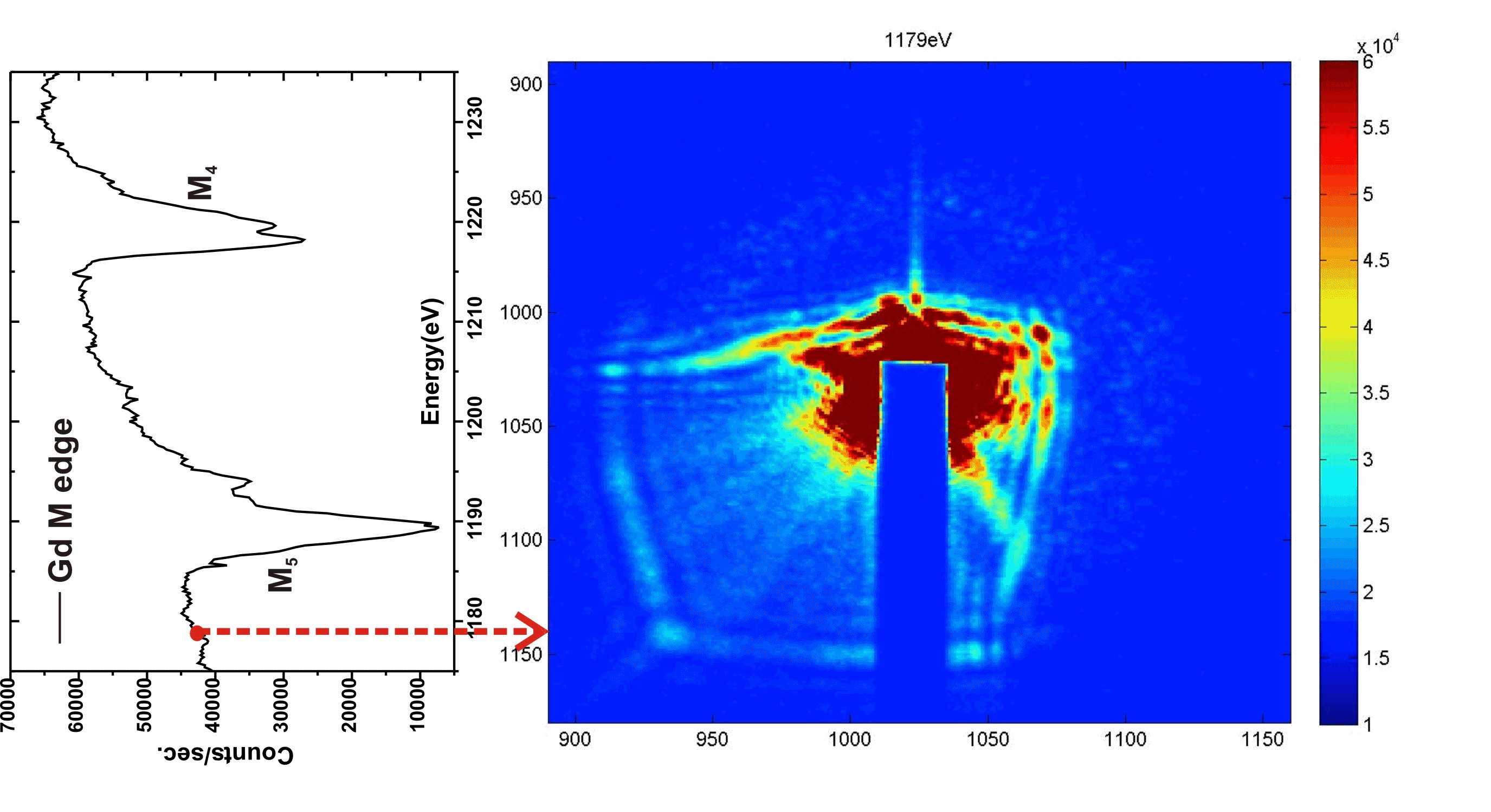 Recently,
we obtained strong resonant magnetic speckles in a multilayer GdFe
system at the Gd M5 edge
at the 2-ID-B beamline at APS. Substantial reduction of magnetic
contrast was observed by measuring away from the resonance peak.
Figure show speckle patterns taken at Gd M5 (1189
eV), M4 (1218
eV) as well at 1179
eV (off the resonant edges).
Recently,
we obtained strong resonant magnetic speckles in a multilayer GdFe
system at the Gd M5 edge
at the 2-ID-B beamline at APS. Substantial reduction of magnetic
contrast was observed by measuring away from the resonance peak.
Figure show speckle patterns taken at Gd M5 (1189
eV), M4 (1218
eV) as well at 1179
eV (off the resonant edges).
Use of resonant coherent x-rays will enable us to gain information about the local disorder on the nano-scale. By analyzing correlations between speckles as a function of q, we can understand spatial distribution of correlations responsible for memory effects as a function of magnetic field and temperature, and identify the role the disorder plays in formation and stability of magnetic domains. Measurement of the speckle as a function of time will enable investigation of the effects of temperature and magnetic-field on domain wall fluctuations. The timescale of the fluctuations generally increases with the wave vector q (directly related to spatial frequencies or length scales for which fluctuations are observed). Analysis involving higher-order intensity correlation functions can yield information on the intermittent dynamics of magnetic switching (as opposed to continuous uniform domain wall propagation), while two-time correlation functions can be used to investigate non-equilibrium (aging) behavior of the system induced by a rapid change in tuning parameter, either the magnetic field or temperature. In future, using x-ray lensless imagingcoupled with scanning `methods to study extended sampleswe can access not only the order-parameter (out-of-plane magnetization), but also the phase, which may provide crucial "hidden" information that is not accessible with STXM, PEEM, MFM or other techniques.
Reference:
Jyoti Mohanty, Ashish Tripathi, Erik Shipton, Keith Chan, SangSoo Kim, Ian McNulty, Eric Fullerton and Oleg Shpyrko, APS March Meeting, Pittsburg, March 16-20, 2009. View Abstract
A. Tripathi, J. Mohanty, O. G. Shpyrko, E. Shipton, E. E. Fullerton, S. S. Kim and I. McNulty, Dichroic coherent diffractive imaging, Proc Natl Acad Sci USA, 108(33)}, 13393-13398 (2011).
Fe/Gd Related:
Stability
of
stripe magnetic domain in magnetic multilayers: Prediction and
observation [1]
Stripes
in thin
ferromagnetic films with out-of-plane anisotropy [2]
Effects
of
magnetostatic coupling on stripe domain structures in magnetic
multilayers with perpendicular anisotropy [3]
Magneto-optics
of Gd and Tb in the soft x-ray resonance regions [4]
Soft
x-ray
resonant magneto-optical constants at the Gd M4,5 and Fe L2,3 edges [5]
Quantitative
imaging of magnetization reversal in FeGd multilayers by magnetic
transmission x-ray microscopy [6]
Experimental
determination of the magnetic phase diagram of Gd/Fe multilayers [7]
Talk and Thesis:
Thomas
Eimüller thesis [8],
Jorge Miguel
thesis [9],
Stan Konings
thesis [10],
J. B.
Goedkoop Talk [11],
Jan
Lüning Talk [12],
Steve Kevan Talk [13] and
youtube video [14]
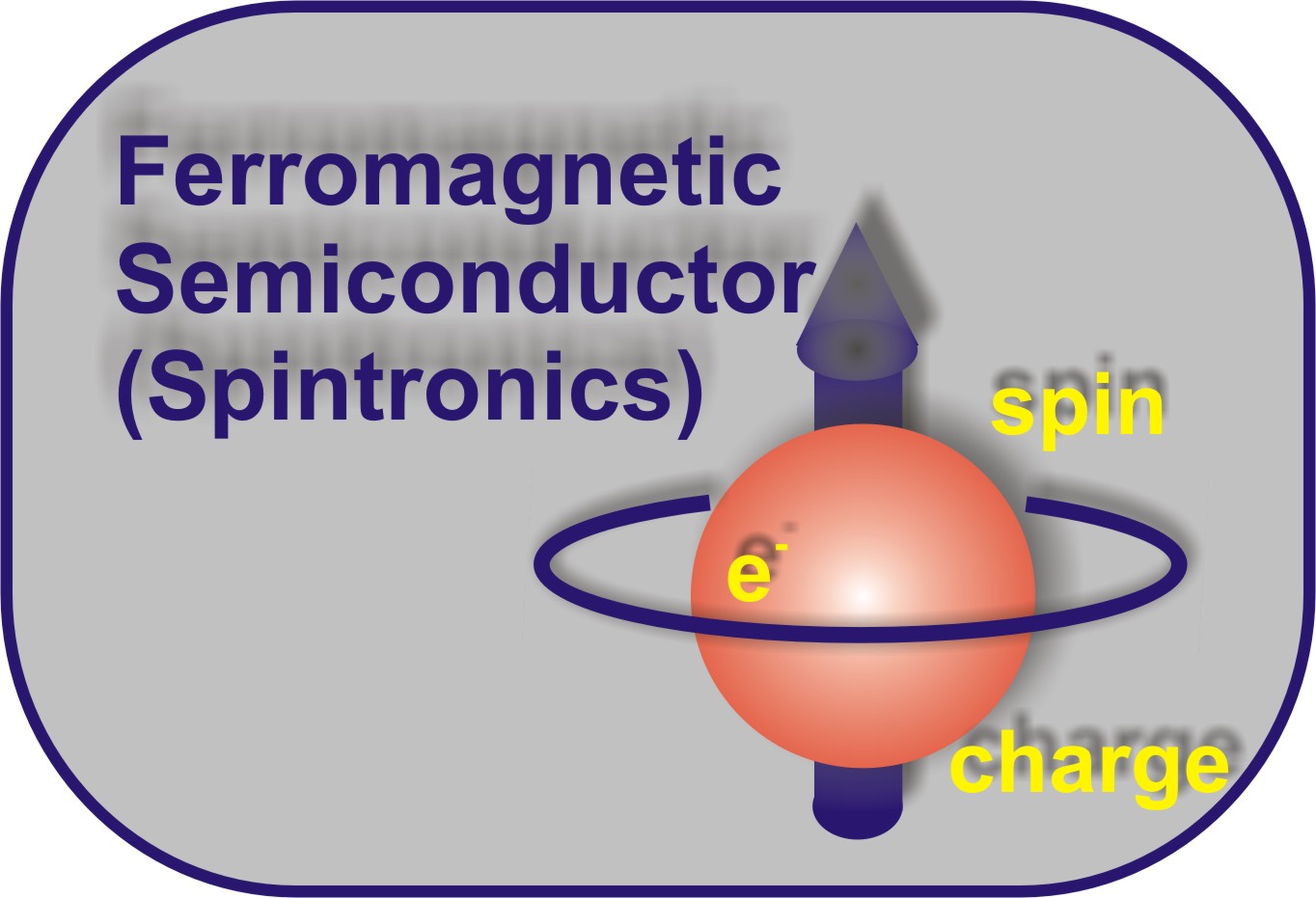
Starting from the discovery of the electric charge, it has been used as a source of information transfer in electronics devices. However, the spin degree of freedom of the electron can be used as a medium for information exchange and transfer. The concept of utilizing spin of the electron along with its charge nature for more functionalityare known as spin-based electronics or so called, spintronics. Certainly, one can ask the question what is the advantage of using spin of the electron in comparison to its charge. To answer this question we have to take into account that spin is non-volatile and again spin has large life time compare to electric charge, therefore we can expect o have devices with higher performances and on the other hand the benefit of the non-volatile data storage technology.The generic spintronics scheme on a prototypical device, the Datta-Das spin field-effect transistor (SFET; Datta and Das, 1990). The scheme shows the structure of the usual FET, with a drain, a source, a narrow channel, and a gate for controlling the current. The gate either allows the current to flow (ON) or does not (OFF). The spin transistor is similar in that the result is also a control of the charge current through the narrow channel. The difference, however, is in the physical realization of the current control. In the Datta-Das SFET the source and the drain are ferromagnets acting as the injector and detector of the electron spin. The drain injects electrons with spins parallel to the transport direction. The electrons are transported ballistically through the channel. When they arrive at the drain, their spin is detected. In a simplified picture, the electron can enter the drain (ON) if its spin points in the same direction as the spin of the drain. Otherwise it is scattered away (OFF). The role of the gate is to generate an effective magnetic field, arising from the spin-orbit coupling in the substrate material, from the confinement geometry of the transport channel, and the electrostatic potential of the gate. This effective magnetic field causes the electron spins to precess. By modifying the voltage, one can cause the precession to lead to either parallel or antiparallel (or anything between) electron spin at the drain, effectively controlling the current.
MnAs on GaAs:
In the frame work of ferromagnetic semiconductor and spintronics I did my Ph.D thesis work on the MBE grown III-V ferromagnetic semiconductor system i.e. MnAs on GaAs substrates. MnAs exhibits a first-order phase transition from the hexagonal, ferromagnetic alpha-phase to the orthorhombic, paramagnetic beta-phase at around 40 degree centigrade. In epitaxial MnAs films on GaAs, it is known that the ferromagnetic and the paramagnetic phases coexist over a wide temperature range of about 30 degree centrigade below the phase transition temperature. In this temperature range, MnAs films on GaAs (001) and (311)A substrates show a regular array of ferromagnetic stripes due to the involved strain. The width of the ferromagnetic stripes can be tuned by varying the temperature, whereas the periodicity of the stripe pattern is found to be a linear function of film thickness. The in part complex micromagnetic domain structure strongly depends on the width and the distance of the ferromagnetic stripes, as it directly affects the shape anisotropy and magnetic coupling, respectively. The films exhibit a strong uniaxial magnetic anisotropy, where the magnetic easy axis is the a-axis (along MnAs [11¯20]) and the magnetic hard axis is the c-axis (along MnAs [0001]) and both axes lie in the film plane. More details can be found in the thesis.
Related Publications: Jyoti Mohanty et.al, Appl. Phys. Lett. 82, 2308-2310 (2003), Appl. Phys. A 77, 739-742 (2003), Appl. Phys. Lett. 83, 2829-2831 (2003), Appl. Phys. Lett. 83, 2850-2852 (2003). Appl. Phys. Lett. 84, 1132 (2004). Physica E 24, 115 (2004). J. Appl. Phys. 96, 5056 (2004). Appl. Phys. A 81, 1359 (2005). J. Appl. Phys. 98, 013907 (2005). J. Vac. Sci. Technol. B 23, 1759 (2005).J. Appl. Phys. 98, 063909 (2005). Phys. Rev. B. 73, 104441 (2006). J. Magn. Magn. Mater. 305, 457 (2006).Appl. Phys. A 84, 231 (2006).Further Reading:
[1]
I. Zutic et al. Rev.
Mod. Phys., 76, 323, 2004
Nobel
Lecture Review
article on spintronics and video Lecture, please click here
